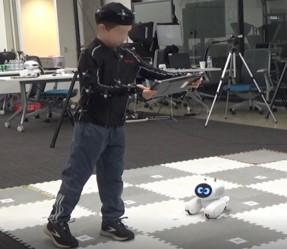Body
Image

From Play to Problem-Solving: Augmented Reality for Enhancing Computational Thinking in Young Learners
This study introduces an innovative augmented reality (AR) environment, augmented by Linibot, a physical robot, to cultivate computational thinking skills in young learners. Integrating AR technology with Linibot, children navigate a grid-like environment on a tablet, guided by the robot through AR obstacles. The objectives include fostering STEM problem-solving, symbol comprehension, and confidence in technology. Pre- and post-tests evaluated the impact on computational thinking in the intervention group of thirty-five children across diverse settings, with a showcase event involving twenty children. Iteratively refined over two and a half years, ongoing analysis of interaction logs aims to assess performance and refine the environment. Preliminary results from five students show significant improvements in task performance, including a 42% decrease in task completion time, an 80% decrease in avoiding difficult problems, and an 80% increase in mission achievements. The tool not only enhances computational thinking but also influences learning behavior, encouraging students to tackle challenges. Future studies will compare control and intervention groups for a comprehensive understanding of the intervention's impact.
Pillar 1: Innovative Use of Technologies in Learning and Teaching
Our project pioneers the integration of augmented reality (AR) technology with a physically embodied robot, Linibot, to enhance early computational thinking skills in young learners. By immersing children in a dynamic AR environment, guided by Linibot, we revolutionize traditional learning methods, making abstract concepts tangible and engaging. Through this innovative approach, we create an interactive and immersive learning experience that fosters STEM problem-solving, symbol comprehension, and confidence in technolog
Pillar 2: Partnerships for Career and Workforce Preparation.
Our project collaborates with educational institutions and technology providers to prepare students for future careers. By integrating cutting-edge AR technology and robotics into early education, we bridge the gap between classroom learning and real-world applications. Through partnerships, we ensure alignment with educational needs, providing students with relevant skills and preparing them for success in STEM fields and the evolving workforce landscape.
Pillar 3: Strategies for Equity in STEM Education
Our project employs inclusive design principles and community engagement to promote equity in STEM education. We prioritize accessibility and representation, ensuring that our AR environment and Linibot platform are inclusive of diverse learners. By partnering with schools and organizations serving underrepresented communities, we aim to address systemic barriers and provide equal opportunities for all students to develop essential computational thinking skills, regardless of background or ability.

Discipline(s)
Computer and informational technology science
Engineering
Emerging Tech (Artificial Intelligence, Quantum Computing, and Blockchain)
Interdisciplinary
Target Gradespan(s)
Early Childhood (PK)
Elementary school (K-5)
Target Participant(s)
Youth / students
Educators
Parents / caregivers / families
Participants with disabilities
Project Setting(s)
Informal Education
Category
Developing and Testing Innovations (DTI)
Research Study
Youth-Based